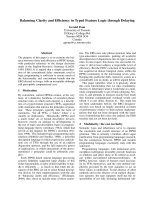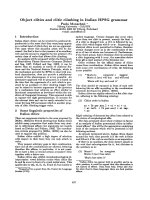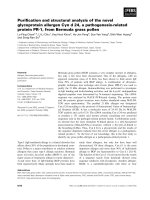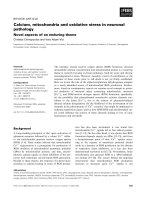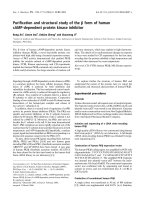Báo cáo khoa học: "Physiological correlations and bud dormancy in the apple tree (Malus domestica Borkh.)" pdf
Bạn đang xem bản rút gọn của tài liệu. Xem và tải ngay bản đầy đủ của tài liệu tại đây (144.85 KB, 3 trang )
Physiological
correlations
and
bud
dormancy
in
the
apple
tree
(Malus
domestica
Borkh.)
O.
Bailly
J.C.
Mauget
laboratoire
de
Bioclimatologie,
INRA,
Domaine-de-Crouelle,
63039
Ctermont-Ferrand
Cedex,
France
Introduction
During
their
autumn
rest
period,
terminal
and
axillary
buds
of
apple
trees
exhibit
dif-
ferent
behaviours:
the
terminal
bud
is
always
much
more
dormant
than
the
axil-
lary
ones
so
that
one
can
wonder
whether
the
latter
are
not
simply
inhibited
by
phy-
siological
correlations
(Williams
et
al.,
1979;
Mauget
and
Rageau,
1988).
To
check
this
hypothesis,
the
following
ex-
periment
was
carried
out
on
apple
trees,
cultivar
Golden
delicious.
Long
shoots
were
defoliated
and/or
pruned
in
fall
and
early
winter
in
order
to
release
buds
from
all
physiological
inhibitive
influences
(apex,
leaves).
The
subsequent
dormancy
of
buds
on
control
and
treated
shoots
was
studied
from
fall
until
budburst
on
the
trees.
Materials
and
Methods
The
trees
(15
yr
old)
were
grown
in
an
orchard
located
in
the
area
of
Clermont-Ferrand.
Groups
of
long
shoots
on
the
trees
were:
a)
defoliated
in
September
and
in
October;
b)
pinched
(elimination
of
the
terminal
bud)
or
pruned
in
their
middle
part
monthly
from
Sep-
tember
until
January;
or
c)
simultaneously
defoliated
and
pruned
or
pinched
in
September
and
October.
Bud
dormancy
on
control
and
treated
shoots
was
studied
with
the
method
of
isolated
node
cuttings.
For
each
treatment,
about
10
shoots
were
collected
at
intervals
of
15
days
and
were
cut
into
8
cm
cuttings
on
which
a
single
node
was
left.
The
cuttings
were
stood
in
water
at
a
constant
temperature
of
20°C
under
long
days
of
16
h.
The
time
needed
for
budburst
of
each
bud
was
recorded
by
daily
observation.
The
average
state
of
dormancy
of
the
population
of
sampled
buds
was
quantified
by
the
mean
time
of
budburst
(MTI3)
expressed
in
days;
this
was
the
arithmetic
mean
of
the
time
to
budburst
for
each
bud
from
a.
given
population
and
at
each
date
of
collection.
The
higher
the
MTB,
the
more
dormant
the
buds.
Distal,
median
or
basal
buds
could
be
studied
separately.
Results
are
expressed
as
the
change
of
MTB
during
the
vegetative
rest
period.
This
described
the
time
course
of
dormancy.
Results
Effects
of
defoliation
(Fig.
1a)
Only
changes
in
dormancy
of
lateral
buds
located
near
the
apex
part
are
shown.
These
buds
became
more
dormant
after
defoliation,
particularly
after
October
treat-
Behaviour
of
other
buds
on
the
stem
was
hardly
affected
by
this
treat-
ment.
Effects
of
pruning
and
pinching
(Fig.
1 b
and c)
Only
the
treatments
done
in
September
and
October
modified
the
course
of
bud
dormancy
(i.e.,
before
the
peak
MTB
in
late
November).
The
intensity
of
dormancy
in
the
uppermost
buds
was
considerably
increased
for
treated
shoots.
These
effects
were
more
important
for
buds
on
shoots
treated
in
September
than
on
those
treated
in
October.
Both
these
treat-
ments
(and
also
defoliation)
accentuated
a
bud
dormancy
gradient
along
the
stem.
The
increase
in
intensity
of
lateral
bud
dormancy
was
slightly
more
important
on
simultaneously
defoliated
and
pinched
or
pruned
shoots
than
on
treated
shoots
(Fig.
1
a or
b)
(data
not
shown).
The
main
differences
between
MTB
values
for
control
and
treated
shoots
in
mid-fall
were
statistically
significant
(Mann
and
Whitney
U test,
5%
level).
Discussion
Removing
inhibitory
influences
from
the
apex
and
leaves
did
not
decrease
the
extent
of
dormancy;
on
the
contrary,
the
intensity
of
bud
dormancy
was
increased
by
September
and
October
treatments.
The
inhibited
state
of
the
lateral
buds
in
apple
could
be
responsible
for
the
shallow
dormancy
exhibited
by
these
buds.
Never-
theless,
the
potential
for
these
buds
to
grow
out
remained
weak.
These
results
are
in
agreement
with
the
hypothesis
developed
by
Barnola
et
al.
(1976)
for
Corylus.
These
authors
suggest
that
the
correlative
influence
from
the
apex
and
properties
associated
with
the
position
of
the
lateral
bud
could
be
factors
that
prevent
acquisition
of
strong
dorman-
cy.
The
situation
of
the
terminal
buds
which
exhibit
strong
dormancy,
could
be
different.
Since
the
uppermost
buds
on
apple
shoots
pinched
and
defoliated
in
the
fall
grow
out
rapidly
when
detached
from
the
trees
(Paiva
and
Robitaille,
1978;
Williams
et al.,
1979;
Latimer
and
Robitaille,
1981
),
a
factor
associated
with
the
whole
plant
(and
to
a
lesser
extent
low
temperature)
is
necessary
to
increase
the
dormancy
of
lateral
buds.
The
induction
of
strong
dor-
mancy
in
the
lateral
buds
can
be
consid-
ered
a
good
means
to
study,
using
struc-
tural
and
biochemical
approaches,
the
mechanisms
involved
in
bud
dormancy
in
apple
trees.
Acknowledgments
Special
thanks
to
J.
Guinard,
N.
Frizot
and
R.
Mege
for
their
technical
collaboration.
References
Barnola
P.,
Charnpagnat
P.
&
Lavarenne
S.
(1976)
Taille
en
vert
des
rameaux
et
dormance
des
bourgeons
chez
le
noisetier.
C.R.
Seances
Acad.
Agric.
Fr.
1 C
I
, 1163-1171
Latimer
J.G.
&
Ro!bitaille
H.A.
(1981)
Sources
of
variability
in
apple
shoot
selection
and
handling
for
bud
rest
determinations.
J.
Am.
Soc.
Hortic.
Sci.
106, 794-798
Mauget
J.C.
&
Ra.geau
R.
(1988)
Bud
dorman-
cy
and
adaptation
of
apple
tree
in
mild
winter
climates.
Acta
Hottic.
232, 101-108
Paiva
E.
&
Robitaille
H.A.
(1978)
Breaking
bud
rest
on
detached
apple
shoots:
effects
of
wounding
and
ethylene.
J.
Am.
Soc.
Hortic.
Sci.
103, 101-104
Williams
R.R.,
Edwards
G.R.
&
Coombe
B.G.
(1979)
Determination
of
the
pattern
of
winter
dormancy
in
lateral
buds
of
apples.
Ann.
Bot.
44, 575-581




